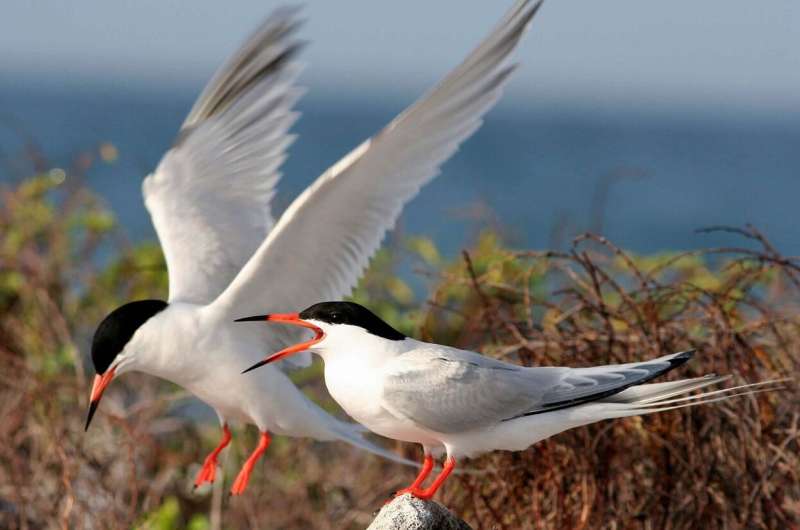Bird rescue operation in Long Beach seeks to save elegant terns

It's been a tough year for elegant terns in Southern California.
A drone crash in June forced an estimated 3,000 of the sleek seabirds with their pointed orange bills to abandon their eggs on Bolsa Chica Ecological Reserve in Orange County. Experts say it's possible that many of the birds set up camp on two commercial barges in nearby Long Beach Harbor.
Now droves of the baby birds are falling into the ocean and drowning.
"They basically landed on the barge a day or so, and it may have been two or three days, after the incident involving the drones when they left Bolsa Chica," said Tim Daly, spokesman for California Department of Fish and Wildlife. "There's really no way of proving or knowing, but we think there's a possibility, because they suddenly appeared."
The birds built a noisy new home atop two 180-foot-long boats piled high with rocks. The barges, run by construction company Connelly-Pacific Co., were preparing for a trip to the Seal Beach Naval Weapons Station to reconfigure them for Navy boats, said Melissa Loebl, reserve manager at Bolsa Chica Ecological Reserve.
But now they're stuck because the federal Migratory Bird Treaty Act prevents the company from moving and disrupting the birds.
Just after July 4th, dozens of dead baby terns washed up on the Long Beach shore. Loebl said she suspected Independence Day fireworks scared some of the birds. The babies—too young to fly and unable to climb back onto the barges, which were sitting at least two feet above water—drowned.
Since then, International Bird Rescue, a conservation group, has rescued 325 baby elegant terns—and collected more than 100 baby carcasses. Many more probably drowned, said Russ Curtis, the organization's spokesman.
"We haven't really determined the full extent of what prompted them to stumble off the barge," Curtis said. "They're noticing the adults are probably in the water, flying around. ... I think they're just stumbling off the barge and there's a pretty big dropoff and they can't get back on."
The terns' tumultuous few months have worried biologists and bird rescuers.
"Elegant terns are very susceptible to disturbance, as has been seen," said JD Bergeron, CEO of International Bird Rescue. "This becomes a conservation issue pretty quickly."
A patchwork of agencies, conservation groups and local volunteers has emerged to conduct emergency rescues of the baby birds.
Every morning for nearly two weeks, two boats sidle up to the terns' new floating home. With their engines low, so as not to scare the birds, the boats circle the barges, searching for wayward baby terns.
The little ones are easy to spot, Bergeron said: Their wings, not quite waterproof yet, quickly sink in the water.
One of the smallest birds he encountered, named "Little Mike," was very low in the water when rescue boats approached Tuesday. The tern slipped underwater for about 20 seconds before rescuers recovered the animal and helped it breathe again.
"That bird was essentially resuscitated from death and is actually doing really great," Bergeron said.
With a swoop of a net, the rescuers scoop the terns from the water and into the boat, where they are dried off, warmed with handwarmers and taken back to the center. There, staffers feed the birds slivers of fish by hand—a tedious operation that often takes several hours, Curtis said.
"It's a little bit like having a baby nursery where you just have to keep feeding," he said.
Staffers wear masks and face shields as they feed the terns, so the birds don't get habituated to their human caregivers. Once the babies fledge at 35 days, International Bird Rescue plans to release the terns back into the wild.
But what to do about the barges in the meantime—and after this generation of baby birds grows up—remains a challenge.
The center is going through an extra 100 pounds of fish a day, Curtis said, and needs donations to continue to care for the rescued birds. Boaters are advised to steer clear of the barges, to avoid disturbing the birds.
Loebl said people are working on a temporary solution to create a ramp, so any birds that fall off the barge can climb aboard again. A trial raft attached to the barge on Thursday seemed to work, she said.
"The ultimate goal is a hands-off approach, which means if we can attach ramps or rafts to the barge to allow the birds to recover themselves, that would be great and ideal," Loebl said.
This is not the first time terns have navigated to the Long Beach Harbor to colonize. In 2006, droves of baby tern carcasses washed up onshore after stampeding off two privately owned barges in the harbor.
The tugboat operator, Ralph Botticelli, told the Los Angeles Times then that he and his workers were attempting to move the barges when they accidentally spooked the birds.
The terns returned the following year, prompting environmentalists to once again propose a more permanent solution: the possible creation of a manmade island.
"The reason we want to do that is these terns keep wanting to nest in the port," Loebl said. "So if they're trying to find habitat because their habitat is limited ... these (are) open spaces for them to breathe."
©2021 Los Angeles Times.
Distributed by Tribune Content Agency, LLC.




















